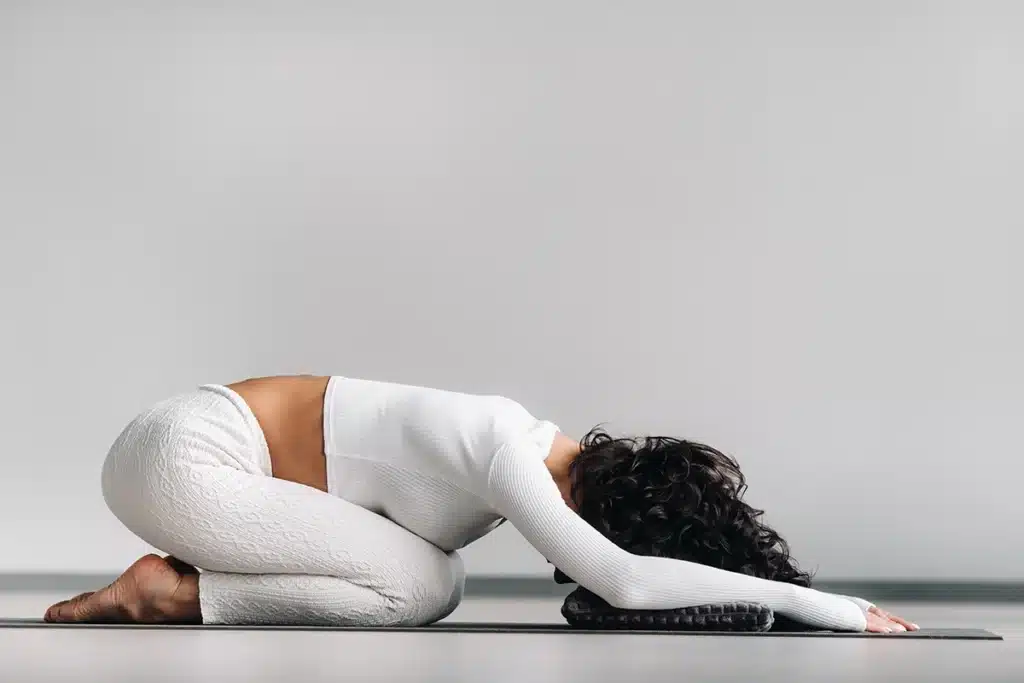
Table of Contents
ToggleHave you ever woken up with a stiff neck and wondered if there’s a better way to sleep? Sleeping positions for neck pain relief might just be the solution you need.
In this article, we’ll explore how the way you sleep can significantly impact your neck health. Understanding the right sleeping positions can transform your night, leading to not just pain relief but also improved sleep quality.
So, if neck pain has been a part of your nightly routine, it’s time to say goodbye to those sleepless nights and hello to mornings filled with comfort and ease.
When it comes to finding relief from neck pain, not all sleeping positions are created equal. The two most recommended positions for mitigating neck pain are side sleeping and back sleeping.
These positions support the natural curvature of your spine, ensuring that your neck isn’t strained through the night.
For side sleepers, it’s crucial to maintain a straight spine. This means your head should be in line with your body, not tilted up or down.
A supportive pillow can make all the difference here. Similarly, back sleeping allows for even distribution of weight across your body, reducing the pressure on any single point in your neck.
Imagine your body lying in perfect harmony, with each part adequately supported, leading to a night free of neck pain.
But why are these positions effective? They help in maintaining the natural alignment of your spine. When your spine is properly aligned, the muscles around your neck don’t have to work overtime to support your head.
This alignment reduces the tension that typically accumulates after a day of looking down at screens or bending over desks.
Your sleeping posture plays a pivotal role in managing and preventing neck pain. An incorrect posture can strain your neck muscles and exacerbate existing pain, turning what should be a restful night into a struggle.
The key lies in understanding the natural alignment of your spine and neck.
Poor sleeping posture isn’t just about discomfort; it can lead to longer-term health issues. When your neck is constantly strained night after night, it can result in chronic pain, affecting your daily activities.
Just as a tree bends in the direction of the wind over time, your neck too can develop a lasting tilt or strain from repeated stress.
Experts suggest that maintaining a neutral position, where your head, neck, and spine are in alignment, can significantly reduce the risk of developing neck pain. This alignment supports the natural curve of your spine, leading to a more restful and rejuvenating sleep.
Imagine your body as a symphony, with each part in perfect harmony, creating a beautiful melody of rest and recovery.
But how do you know if your posture is right? A simple test is to notice how you feel when you wake up.
If you often wake up with stiffness or soreness in your neck, it might be time to reevaluate your sleeping posture. Consulting with a healthcare professional can also provide personalized advice, especially if you have an existing condition that affects your sleep posture.
Remember, the goal is not just to alleviate pain temporarily but to foster a sleeping environment that supports long-term neck health. By paying attention to the way you sleep, you can make significant strides towards a healthier, more comfortable life.

Choosing the right pillow is like finding the perfect companion for your sleep journey. It’s not just about comfort; it’s about support.
For those seeking sleeping positions for neck pain relief, the choice of pillow can be a game-changer.
Different types of pillows cater to different needs. Memory foam pillows, for instance, conform to the shape of your neck, providing consistent support throughout the night.
Feather pillows, on the other hand, offer a softer feel but may need frequent replacement as they tend to lose their shape over time.
The height and firmness of your pillow play a critical role too. A pillow that’s too high or too firm can leave your neck at an awkward angle, causing strain.
Conversely, a pillow that’s too soft may not offer enough support, leading your neck to bend unnaturally.
But it’s not just about the pillow under your head. Additional supports, like a small pillow or rolled-up towel under your neck, can enhance the alignment further, particularly for back sleepers.
For side sleepers, a pillow between the knees can help maintain hip alignment, indirectly benefiting the neck.
So, when selecting your pillow, think about how it will work with your preferred sleeping position. It’s about creating a cohesive sleep environment where each element works in harmony to support your neck and spine.
Living with neck pain doesn’t mean you have to dread bedtime. By following some simple dos and don’ts, you can significantly improve your sleep quality and wake up feeling refreshed.
By incorporating these simple practices into your nightly routine, you can create an environment that nurtures your neck and spine, setting the stage for a pain-free night’s sleep.

A little preparation can go a long way, especially when it comes to preventing neck pain. Incorporating some gentle stretches and exercises into your bedtime routine can make a significant difference in how you feel in the morning.
Simple neck rotations, tilting your head from side to side, and gentle shoulder rolls are a great place to start. These movements help to relax your muscles and increase flexibility, reducing the likelihood of pain and stiffness.
It’s like giving your neck a gentle hug, telling it to relax and prepare for a restful night.
You can also try some specific stretches for your neck and upper back. For instance, gently pulling your head towards each shoulder can help stretch the sides of your neck.
Remember to keep these stretches slow and gentle; the goal is not to strain but to soothe.
Incorporating these exercises into your routine doesn’t just provide immediate relief; it also strengthens the muscles over time, offering long-term benefits. Just a few minutes each night can contribute to a healthier neck, better posture, and more comfortable sleep.
Changing your sleeping position can feel as challenging as changing a long-standing habit. But with patience and the right approach, it’s entirely possible.
If you’re transitioning to a new position to find sleeping positions for neck pain relief, here are some steps to make it easier.
First, set up your sleeping environment to support the new position. This might mean rearranging pillows or adding new supports.
For instance, if you’re transitioning to side sleeping, placing a pillow between your knees can help maintain alignment.
It’s also important to be patient with yourself. Changing a sleeping position is a gradual process.
You might find yourself reverting to your old position during the night. That’s okay. With time, your body will adapt to the new position.
Using props like body pillows can also assist in this transition. They provide a physical reminder of the new position and prevent you from easily flipping back to your old posture.
Remember, consistency is key. Stick with your new position for several weeks to give your body the chance to adjust.
Over time, this new position will start to feel natural, and you’ll begin to notice the benefits in terms of reduced neck pain and better sleep quality.

Adopting the right sleeping positions offers more than just immediate pain relief. There are significant long-term benefits to be gained as well.
Firstly, consistent use of proper sleeping positions can help prevent the development of chronic neck pain. It’s a proactive approach to maintaining neck health, rather than a reactive one.
Over time, maintaining good sleeping positions also contributes to better overall spinal health. This can lead to improved posture and reduced risk of other related issues, like chronic back pain.
Additionally, good sleep posture contributes to better sleep quality. When your body is correctly aligned and comfortable, you’re less likely to wake up during the night, leading to more restorative, uninterrupted sleep.
Ultimately, these practices contribute to a higher quality of life. With reduced pain and better sleep, you’re more likely to have increased energy, better mood, and greater ability to focus during the day.
When dealing with specific medical conditions related to neck pain, the choice of sleeping position becomes even more critical. Certain conditions may require special considerations to ensure that your sleep posture supports your recovery and doesn’t exacerbate your pain.
For instance, those with herniated discs may find relief in sleeping on their side in a fetal position, as it can help reduce the pressure on the discs. On the other hand, individuals with osteoarthritis may benefit more from back sleeping with a pillow under their knees to reduce spine stress.
It’s important to consult with healthcare professionals, such as those at Long Island Neuroscience Specialists, to tailor your sleeping position and environment to your specific needs. They can provide personalized advice based on your condition and overall health.
Adjusting your sleep position and environment in response to medical advice can significantly improve not only your neck pain but also the effectiveness of other treatments you may be undergoing.
As we draw to the close of our journey through the world of sleeping positions for neck pain relief, let’s take a moment to reflect on the key takeaways. We’ve explored various effective sleeping positions, understood the crucial role of posture, delved into the significance of pillows and supports, and navigated the dos and don’ts for optimal neck health during sleep.
We’ve also seen how pre-bedtime stretches and exercises can enhance our efforts, and the importance of patience and consistency when transitioning to a new sleeping position.
The journey to finding comfort in sleep with neck pain is not just about a single night; it’s about creating a sustainable and healthy sleep routine that supports your neck and spine in the long run. Embracing these practices can lead to profound improvements in both your sleep quality and overall well-being.
So tonight, as you prepare for bed, remember the tips and insights shared. Adjust your pillow, find your ideal position, and relax into a world where sleep brings healing and comfort.
Here’s to finding relief and embracing restful nights ahead!
GET IN TOUCH +
285 Sills Road
Building 5-6, Suite E
East Patchogue, NY 11772
(631) 475-5511
184 N. Belle Mead Road
East Setauket, NY 11733
(631) 675-6226
GET IN TOUCH +
285 Sills Road
Building 5-6, Suite E
East Patchogue, NY 11772
(631) 475-5511
184 N. Belle Mead Road
East Setauket, NY 11733
(631) 675-6226
SUBSCRIBE TO OUR NEWSLETTER +
Send us a Google review. Click this link and let us know how we did!
Review us on Yelp too.